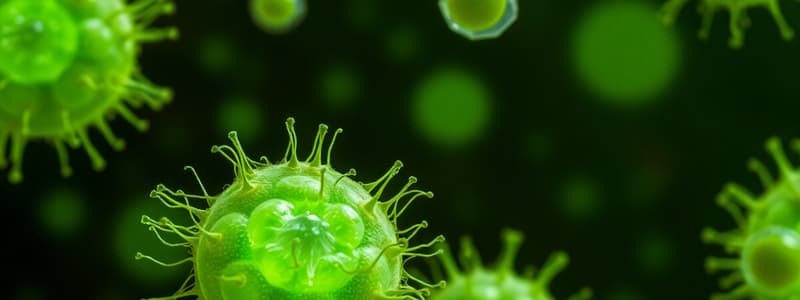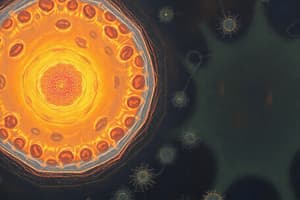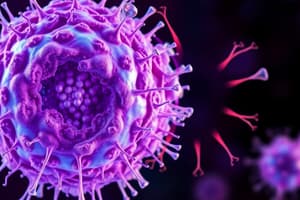Podcast
Questions and Answers
What is the primary function of the nucleus in eukaryotic cells?
What is the primary function of the nucleus in eukaryotic cells?
- Storage of proteins
- Transport of materials across membranes
- Synthesis of ATP
- Control center for genetic information (correct)
Which structure is responsible for controlling the movement of proteins and RNAs across the nuclear envelope?
Which structure is responsible for controlling the movement of proteins and RNAs across the nuclear envelope?
- Nuclear lamina
- Chromatin
- Nucleoplasm
- Nuclear pore complexes (correct)
What is the main difference between chromatin and nucleolus?
What is the main difference between chromatin and nucleolus?
- Chromatin synthesizes proteins, while nucleolus stores DNA.
- Nucleolus contains enzymes; chromatin is solely composed of RNA.
- Chromatin is involved in rRNA synthesis; nucleolus contains DNA.
- Nucleolus is a dense mass associated with the nuclear envelope; chromatin is not. (correct)
Which of the following statements about the nucleolus is incorrect?
Which of the following statements about the nucleolus is incorrect?
Mitochondria are known as the powerhouse of the cell primarily due to their role in:
Mitochondria are known as the powerhouse of the cell primarily due to their role in:
What feature allows mitochondria to change shape under different metabolic conditions?
What feature allows mitochondria to change shape under different metabolic conditions?
In eukaryotes, where does DNA replication and RNA transcription occur?
In eukaryotes, where does DNA replication and RNA transcription occur?
Which of the following statements regarding mitochondria is true?
Which of the following statements regarding mitochondria is true?
Which of the following organelles is associated with the synthesis of ribosomal RNA?
Which of the following organelles is associated with the synthesis of ribosomal RNA?
What role does catalase enzyme play in peroxisomes?
What role does catalase enzyme play in peroxisomes?
Which enzyme is NOT found in the nucleolus?
Which enzyme is NOT found in the nucleolus?
Which statement about cytoplasm is incorrect?
Which statement about cytoplasm is incorrect?
What is a primary function of the plasma membrane?
What is a primary function of the plasma membrane?
Which component typically does not contribute significantly to cellular membranes?
Which component typically does not contribute significantly to cellular membranes?
In eukaryotic cells, what is the role of the internal membrane systems?
In eukaryotic cells, what is the role of the internal membrane systems?
What is the main component of the outer mitochondrial membrane?
What is the main component of the outer mitochondrial membrane?
What percentage of membrane composition typically consists of carbohydrates?
What percentage of membrane composition typically consists of carbohydrates?
Which of the following does not describe peroxisomes?
Which of the following does not describe peroxisomes?
Which proteins are responsible for allowing substances to diffuse across the outer mitochondrial membrane?
Which proteins are responsible for allowing substances to diffuse across the outer mitochondrial membrane?
What is the lipid-protein ratio in the inner mitochondrial membrane?
What is the lipid-protein ratio in the inner mitochondrial membrane?
What is the major characteristic of membrane permeability?
What is the major characteristic of membrane permeability?
Which statement about the intermembrane space is true?
Which statement about the intermembrane space is true?
The cristae in the inner mitochondrial membrane serve what purpose?
The cristae in the inner mitochondrial membrane serve what purpose?
Which of the following is NOT found in the mitochondrial matrix?
Which of the following is NOT found in the mitochondrial matrix?
What type of biomolecules are abundant in the inner mitochondrial membrane?
What type of biomolecules are abundant in the inner mitochondrial membrane?
What causes the inflammation associated with gout?
What causes the inflammation associated with gout?
Which statement about the function of the outer mitochondrial membrane is correct?
Which statement about the function of the outer mitochondrial membrane is correct?
What is a key characteristic of I-cell disease?
What is a key characteristic of I-cell disease?
What specific enzyme deficiency is associated with I-cell disease?
What specific enzyme deficiency is associated with I-cell disease?
What is contained within the mitochondrial matrix?
What is contained within the mitochondrial matrix?
Which feature distinguishes the inner mitochondrial membrane from the outer mitochondrial membrane?
Which feature distinguishes the inner mitochondrial membrane from the outer mitochondrial membrane?
How are enzymes affected in individuals with lysosome-related inherited disorders?
How are enzymes affected in individuals with lysosome-related inherited disorders?
What is a defining feature of peroxisomes?
What is a defining feature of peroxisomes?
Which characteristic is unique to prokaryotic cells when compared to eukaryotic cells?
Which characteristic is unique to prokaryotic cells when compared to eukaryotic cells?
What role does the mitochondria play in eukaryotic cells?
What role does the mitochondria play in eukaryotic cells?
Which statement accurately reflects a key principle of cell theory?
Which statement accurately reflects a key principle of cell theory?
What is a defining feature of eukaryotic cells regarding their internal organization?
What is a defining feature of eukaryotic cells regarding their internal organization?
Which type of cell does not undergo mitosis or meiosis for reproduction?
Which type of cell does not undergo mitosis or meiosis for reproduction?
In eukaryotic cells, where are the informational components collectively known as chromatin located?
In eukaryotic cells, where are the informational components collectively known as chromatin located?
Which of the following organisms would be classified as prokaryotic?
Which of the following organisms would be classified as prokaryotic?
Which process encompasses both anabolism and catabolism within a cell?
Which process encompasses both anabolism and catabolism within a cell?
What is the size comparison between prokaryotic and eukaryotic cells?
What is the size comparison between prokaryotic and eukaryotic cells?
Which of the following statements about the respiratory system in prokaryotic cells is true?
Which of the following statements about the respiratory system in prokaryotic cells is true?
Flashcards
Peroxisome Function
Peroxisome Function
Peroxisomes carry out oxidation reactions, producing hydrogen peroxide (H₂O₂). Catalase destroys this peroxide. They also have a key role in fatty acid oxidation.
Cytosol
Cytosol
The fluid part of the cytoplasm, free of organelles; composed of water, enzymes, and other dissolved substances. The site of many metabolic reactions.
Plasma Membrane
Plasma Membrane
The outer boundary of a cell that controls what enters and leaves the cell. It separates the cell's interior from the outside environment.
Selective Permeability
Selective Permeability
Signup and view all the flashcards
Membrane Composition
Membrane Composition
Signup and view all the flashcards
Cell Membrane Carbohydrates
Cell Membrane Carbohydrates
Signup and view all the flashcards
Zellweger Syndrome
Zellweger Syndrome
Signup and view all the flashcards
Membrane and Organelles
Membrane and Organelles
Signup and view all the flashcards
Nucleus Function
Nucleus Function
Signup and view all the flashcards
Nuclear Envelope
Nuclear Envelope
Signup and view all the flashcards
Nuclear Pore Complexes
Nuclear Pore Complexes
Signup and view all the flashcards
Chromatin
Chromatin
Signup and view all the flashcards
Nucleolus Function
Nucleolus Function
Signup and view all the flashcards
Mitochondrion Function
Mitochondrion Function
Signup and view all the flashcards
Mitochondrion Size
Mitochondrion Size
Signup and view all the flashcards
Mitochondrion Shape
Mitochondrion Shape
Signup and view all the flashcards
Number of Mitochondria
Number of Mitochondria
Signup and view all the flashcards
Nucleoplasm
Nucleoplasm
Signup and view all the flashcards
Outer mitochondrial membrane composition
Outer mitochondrial membrane composition
Signup and view all the flashcards
Porin protein function
Porin protein function
Signup and view all the flashcards
Outer membrane proteins
Outer membrane proteins
Signup and view all the flashcards
Inner mitochondrial membrane composition
Inner mitochondrial membrane composition
Signup and view all the flashcards
Inner mitochondrial membrane folds
Inner mitochondrial membrane folds
Signup and view all the flashcards
Intermembrane space composition
Intermembrane space composition
Signup and view all the flashcards
Mitochondrial matrix location
Mitochondrial matrix location
Signup and view all the flashcards
Mitochondrial matrix function
Mitochondrial matrix function
Signup and view all the flashcards
Cardiolipin
Cardiolipin
Signup and view all the flashcards
Cristae
Cristae
Signup and view all the flashcards
Gout: Urate Crystals
Gout: Urate Crystals
Signup and view all the flashcards
Lysosomal Storage Disease
Lysosomal Storage Disease
Signup and view all the flashcards
I-Cell Disease
I-Cell Disease
Signup and view all the flashcards
GlcNAc Phosphotransferase
GlcNAc Phosphotransferase
Signup and view all the flashcards
Peroxisomes: Microbodies
Peroxisomes: Microbodies
Signup and view all the flashcards
Cell Theory
Cell Theory
Signup and view all the flashcards
Prokaryotic Cells
Prokaryotic Cells
Signup and view all the flashcards
Eukaryotic Cells
Eukaryotic Cells
Signup and view all the flashcards
What are Histones?
What are Histones?
Signup and view all the flashcards
What is the respiratory site in prokaryotic cells?
What is the respiratory site in prokaryotic cells?
Signup and view all the flashcards
What is the respiratory site in eukaryotic cells?
What is the respiratory site in eukaryotic cells?
Signup and view all the flashcards
What is the function of the nucleus?
What is the function of the nucleus?
Signup and view all the flashcards
What is chromatin?
What is chromatin?
Signup and view all the flashcards
What is Metabolism?
What is Metabolism?
Signup and view all the flashcards
What is Anabolism?
What is Anabolism?
Signup and view all the flashcards
Study Notes
Cell and Cell Organelles
- Cells are the fundamental units of life, forming all animal tissues, including humans.
- When cells die, tissues perish and stop functioning.
Cell Theory
- Each organism is composed of cells.
- All cells arise from other cells.
- Genetic code is passed down from one generation to the next to keep cells functioning and create new ones.
- Metabolism (anabolism and catabolism) encompasses the chemical events (reactions) within an organism's cells.
Types of Cells
- Two main types of cells exist in nature: prokaryotic and eukaryotic cells.
Prokaryotic Cells
- Typically smaller in size and have minimal internal organization.
- Lack membrane-bound organelles.
- Genetic material (DNA) is not enclosed by a nuclear membrane.
- DNA is not complexed with histones.
- Respiratory system is closely associated with the plasma membrane.
- Reproduction does not involve mitosis or meiosis.
- Examples include bacteria and cyanobacteria.
Eukaryotic Cells
- Larger and more complex than prokaryotic cells.
- Have a high degree of internal structure with various membrane-bound organelles.
- Nucleus is the site for informational components (chromatin).
- Reproduction involves both mitosis and meiosis.
- Respiratory site is the mitochondria.
- Examples include fungi, plants, and animals (including humans).
Cell Organelles: Nucleus
- Contains over 95% of the cell's DNA.
- Controls the eukaryotic cell.
- Nuclear envelope: A double membrane separating the nucleus from the cytosol.
- Nuclear pore complexes: Embedded in the nuclear envelope, regulate the movement of proteins and RNA across the nuclear envelope.
- Chromatin: DNA in the nucleus, coiled into a dense mass.
- Nucleolus: A second dense mass associated with the inner nuclear envelope, synthesizes ribosomal RNA (rRNA).
- Nucleoplasm: Contains various enzymes like DNA and RNA polymerases for mRNA and tRNA synthesis.
- Functions: DNA replication, RNA transcription, and major metabolic activity of the nucleus.
Cell Organelles: Mitochondria
- The "powerhouse of the cell."
- Number: Varies greatly between cell types (e.g., some algae have one, while protozoa can have millions).
- Size: Typically 0.2-0.8 μm in diameter.
- Shape: Adaptable, assuming different shapes under varying metabolic conditions.
- Mitochondrial Membranes:
- Outer membrane: Consists mostly of phospholipids and cholesterol, containing Porin protein.
- Inner membrane: Highly folded (cristae), abundant in proteins and cardiolipin, resistant to the passage of most polar and ionic molecules, requiring specialized transport proteins.
- Intermembrane space: The space between the outer and inner membranes; ionic composition similar to the cytosol.
- Mitochondrial matrix: The region enclosed by the inner membrane; contains enzymes for the citric acid cycle, fatty acid oxidation, circular DNA, ribosomes, and enzymes for mitochondrial protein synthesis. Mitochondria have their own genome.
- Functions: Carrying out oxidation reactions producing hydrogen peroxide (H₂O₂), destroyed by the catalase enzyme.
- β-oxidation system capable of oxidizing long-chain fatty acids (C16 to 18 or > C18).
- Diseases: Age-related degenerative disorders (e.g., Parkinson's disease) and inherited disorder (e.g., Zellweger's syndrome) can be linked to mitochondrial dysfunction.
Cell Organelles: Endoplasmic Reticulum (ER)
- Extends from the cell membrane, surrounds mitochondria, and appears to connect to the Golgi apparatus.
- Involved in protein synthesis, transport, modification, storage, and secretion.
- Two types: Rough ER (with ribosomes) and Smooth ER (without ribosomes).
- Rough ER roles in synthesizing membrane lipids and secretory proteins, modifying them, and transporting them throughout the cell.
- Smooth ER's roles include lipid synthesis and modification of proteins generated in rough ER, detoxification of drugs, and other vital functions.
- Dysfunction: Linked to neurological disorders like cerebral ischemia, sleep apnea, Alzheimer's disease, and multiple sclerosis.
Cell Organelles: Golgi Complexes
- Also known as Dictyosomes, these are stacks of smooth compartments in eukaryotic cells.
- Often associated with ER.
- Structure: Includes proximal, medial, and distal compartments.
- Function: Sorting center for newly synthesized proteins containing signal or transit peptides (transport). Proteins lacking these peptides are rejected.
- Subsequent Functions: Receives new proteins from ER, modifies them (e.g., attaching carbohydrates/lipids), packages them into vesicles (secretory vesicles), and transports them to their destination in/out of the cell via exocytosis.
- Diseases related to genetic mutations in Golgi proteins and impaired membrane trafficking. (e.g., Wilson's disease).
Cell Organelles: Lysosomes
- Contain hydrolytic enzymes.
- Digestive bodies within the cell.
- Involved in digestion (breakdown) of various cellular components and foreign molecules.
- pH lower than cytosol (optimal around 5) ensuring proper activity.
- Active during autolysis and in autophagic processes.
- Involved in cellular degradation within cells.
- Diseases involving malfunction can lead to build-up and improper functioning of various cell components or diseases such as I-cell disease.
Cell Organelles: Peroxisomes
- Small organelles sometimes called Microbodies.
- Present in eukaryotic cells, approximately 0.5 µm in diameter.
- Formed by budding from smooth ER.
- Contain oxidases, catalase, and other enzymes involved in various metabolic reactions in which hydrogen peroxide is generated and then degraded, contributing to various metabolic pathways that maintain homeostasis.
- Deficiencies in these enzymes can result in diseases like Zellweger syndrome.
Cell Organelles: Cytosol
- Simplest structure of the cell.
- Cellular fluid surrounding organelles.
- Contains free ribosomes, often in polysome form, and many proteins.
- Site of numerous metabolic reactions.
Biological Membranes (Structure and Function):
- Plasma membrane: A prototype cell membrane, separating cell contents from the external environment; this separation is necessary for life.
- Selective permeability: The property of allowing controlled movement of molecules/ions into and out of the cell (essential for survival).
- Membrane proteins: Integral and peripheral proteins have roles in cellular communication, and facilitated transport; they also provide structural support for cells.
- Carbohydrates: Attached to proteins or lipids (glycoproteins and glycolipids). They are vital for cell-cell recognition and communication.
Chemical Composition of Membranes: Lipids
- Building blocks of cell membranes.
- Amphipathic molecules: A polar head (attracted to water) and nonpolar tails (repelled by water).
- Types: Fatty acids, glycerophospholipids (e.g., phosphatidylcholine, phosphatidylethanolamine), sphingolipids (e.g., sphingomyelin), and cholesterol.
Chemical Composition of Membranes: Proteins
- Integral membrane proteins: Embedded within the membrane, often extending across the entire structure.
- Peripheral membrane proteins: Situated on the surface of the membrane; they can be associated with integral proteins or the lipid bilayer.
Studying That Suits You
Use AI to generate personalized quizzes and flashcards to suit your learning preferences.




